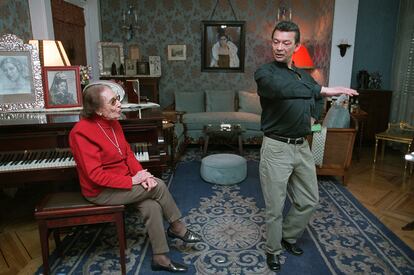Flamenco dance has perhaps lost the last of the pillars that sustained and illuminated it in the second half of the 20th century. Eduardo Serrano Iglesias The Güito He died on Wednesday afternoon as a result of a brief but serious illness. He died in the hospital in Villalba (Madrid), the city to which he moved from his neighborhood of La Concepción when he abandoned teaching at the Academia Amor de Dios, where he taught for many years. Precisely, it was its director, Joaquín San Juan, who confirmed the death of the artist to this newspaper.
The dancer was born in the Madrid neighborhood of El Rastro in 1942 and, from a very young age, he already showed his artistic abilities: when he was only five years old he won his first competition and, while still a child, he put his dance in several films in the early 1950s. . He had a self-taught training, watching artists—among them Farruco, his first reference—in the colmaos and tablaos, where his mother worked as a match girl, before entering the academy of Antonio Marín, “the lame man from Madrid who threw out “walk the modern dance”, in the words of flamenco expert producer and writer José Manuel Gamboa. He would end up being a repeater when the teacher’s leg was amputated.
His career would change radically when, at only fourteen years old, he joined Pilar López’s company, which would make his debut in London. The dancer would always acknowledge that he learned everything from her: “To be respectful, punctuality, to dress, what a stage was, choreography, what it was to dance as a man…”. The teacher reciprocated in fair measure and thus, in 1988, she declared to the magazine Flamenco Seville that “(El Güito) was like the land itself. A force, a root so strong that it already rises to the sky.” He remained with her until 1959, the year in which, performing with Doña Pilar’s company, he would be crowned at the Theater of Nations in Paris as “the best dancer of the season”, a diploma that the artist has kept like gold. .
The Parisian distinction catapulted him to begin his solo career, performing in tablaos and touring abroad. He later participated in shows such as The Tarantos, by Rovira Veleta, and collaborated with the dancer Manuela Vargas in the Flamenco dramatic anthology, before, at the beginning of the seventies, he formed a partnership with Mario Maya and Carmen Mora to form the famous Trío Madrid, with a renewed dance concept and a format that would find continuity four years later, already with the dancer Antonia Martínez.
It was at that time that his soleá dance was consolidated and gained brilliance, which would become an emblem of his work and the canon of men’s dancing. The dancer admitted his predilection and identification with that style in 1996 when, in an interview with Monika Bellido (El Olivo Magazine)declared: “It has been the dance that has consecrated me to be what I am (…) It is where I feel best, most at ease. It gives me more pleasure, because it is where you can dance more slowly.” However, this would not be the only style in which he would stand out: his farruca is recognized, as is his solemn cane or his sober seguiriya, styles that today constitute unquestionable examples of classical men’s dance.
Already in the eighties, in addition to acting as a guest artist of the National Ballet, he presented his first own shows and visited the main events and festivals like the figure he is. His extensive and rich career from beginning to end spans more than half a century and is an exponent of flamenco dance and life of an entire era. They say that in his last years he was somewhat forgetful, that is why, and so that so much history would not be lost, José Manuel Gamboa acted as a kind of corkscrew of memories to, “with the mnemonic collaboration of Joaquín San Juan and the teachers José de la Vega and Emilio de Diego”, stand up and (re)construct their experiences in the book The head of flamenco. Facts and works of the teacher Eduardo Serrrano ‘El Güito’, which, with his personal style, he subtitled as MP-Repaired memories of a forgetful reedbed. Almost four hundred pages of exhaustive information to travel for a long time.
The dance of El Güito, due to its refined aesthetics, elegance and sobriety, has been of great influence on the dance of subsequent generations. Together with Antonio Gades and Mario Maya, they formed the unique trio that Doña Pilar proudly referred to as “my children.” He, in addition, after his retirement continued to transmit his wisdom, teaching at the Amor de Dios Dance Academy. And what cannot be ignored: for the time in which he lived, his dances are available on networks and platforms and are an object of worship for those who want to imbibe his art.
Defining it is not an easy task, that is why it is necessary to go to the word of another teacher, Professor José Luis Navarro García, who in his History of flamenco dance (Volume II), He condensed it masterfully: “His dance is the quintessence of Apollonian dance. Each movement is a sculptural attitude. It is a sober, slow, elegant and manly dance. A dance that lacks nothing and has nothing left over. A dance that has poise and elegance. And the precise decoration. A dance done slowly and with pleasure, listening and letting it be heard. A dance in which composure and positioning prevail, in which the arms, head and shoulders play a prominent role. With them, he builds figures with an old aesthetic. “El Güito imprints his personality on all the dances he performs.”

